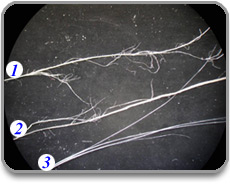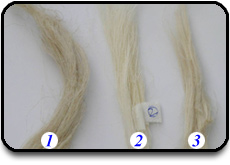NRC technology could help clothe Canadian athletes at the 2010 Winter Olympics in Whistler, B.C. and help pave the way for a range of advanced products made with industrial hemp, such as auto parts and airplane fuselages.
NRC recently entered into a collaboration with Vancouver-based Hemptown Clothing Inc., a manufacturer of hemp clothing that has promoted the idea of using hemp fabric for the uniforms of Canada’s 2010 Olympic team.
Under the partnership, Hemptown will work with the NRC Institute for Biological Sciences (NRC-IBS) to commercialize NRC-developed enzyme technology for processing hemp fabric (enzymes are used widely in industrial applications for everything from pulp bleaching to meat tenderizers).

From top to Bottom:
1. European enzyme-treated fibre
2. Chinese fibre
3. NRC enzyme-treated fibre
The technology promises dramatically improved fibre quality (softer, whiter fabric) using environmentally friendly methods. The collaboration stems from work by Dr. Wing Sung, an NRC-IBS researcher and an expert in the use of enzymes for industrial applications.
Creating Business Opportunities
“We would like to help our partner to make an economic impact as soon as possible. Hopefully, this will whet the appetite of other players to jump in and start using the enzymatic approach to process other parts of the hemp plant. With clean strong fibres made available by our process, we can stimulate the development of many different advanced products.” (Dr. Wing Sung, NRC-IBS)
“There’s no problem growing industrial hemp in Canada. Canadian companies are also effective in selling the finished hemp products. The problem is that Canada lacks the expertise and technology for processing,” Dr. Sung explains. Indeed, earlier efforts to build a hemp processing facility in Manitoba were unsuccessful.
To ensure market success, a processing facility requires a low-cost and environmentally friendly processing technology that produces superior quality hemp fibres. Initial results from the enzyme technology reveal striking improvements in the quality and performance of hemp fibres using this approach. “We are now able to produce hemp fibre of higher quality than that produced in China and Europe,” Dr. Sung says.
China, the world’s leading producer of hemp fabric uses chemical methods for processing, while producers in Europe have begun using cleaner biologically-based enzyme technology. Neither method produces fabric with the same whiteness and softness as cotton. As a consequence, most hemp clothing tends to be blended with cotton, a plant with a long history but which, from an environmental perspective, consumes far more resources than hemp.
The goal is to produce hemp fibres superior to cotton in strength, durability, warmth and moisture-absorbance, yet with the same softness and brightness, via a non-chemical process. “We are excited about new possibilities for producing a home-made Canadian hemp-based fabric with the NRC,” notes Jason Finis, President of Hemptown.

From left to right:
1. European enzyme-treated fibre
2. NRC enzyme-treated fibre
3. Chinese fibre
The NRC-IBS team made a deliberate decision to work with a commercially-available enzyme rather than starting from scratch (a longer process) and has focused on optimizing the conditions under which this enzyme operates. For example, Dr. Sung has been studying the optimum operating temperature for the enzyme processing. In general, the higher the temperature the higher the activity level, but higher temperatures also mean higher energy costs for producers.
Other adjustments have been made to pH levels to avoid damages to the fibres and the processing equipment. Dr. Sung notes that the use of enzymes for processing is well known, however, as this optimization approach demonstrates, improvement is possible. “It’s not a secret using enzymes, but there is still lots of room to establish your own unique opportunity to make the process work faster, better and cleaner,” he says.
Dr. Sung designed the NRC xylanase enzyme (Biobrite ), widely used today for the production of bleached pulp, and is candid about the challenges faced by the team. “Environmental benefits are, of course, extremely important but if you are unable to produce something that will save money for the producer, the technology won’t fly.” Time will tell but initial results are encouraging.
Copyright © 2004, National Research Council Canada. All rights reserved.
(Vgl. Meldungen vom 2004-06-04 und 2003-04-01.)
Source
Global Hemp-News vom 2004-07-08.
Share
Renewable Carbon News – Daily Newsletter
Subscribe to our daily email newsletter – the world's leading newsletter on renewable materials and chemicals









